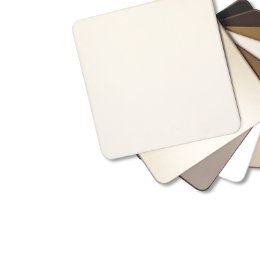Five Tips for Specifying Metal Composite Material

If the versatility of metal composite materials (MCM) has caught your eye or you’ve heard how its light weight and rigidity make it easy to fabricate, you may be ready to add MCM to your next project specification. But where do you start? Writing specifications that include MCM can be intimidating. Some design teams have templates that get recycled which leads to a choppy mess of pieced together project information. Even though most manufacturers offer canned specs designed to make the process easier, there is still room for confusion. One big obstacle is how to effectively translate what specifiers are requesting into clear language understood by contractors. Michael Bowie, technical support specialist for Chesapeake, Va.-based Mitsubishi Chemical America's ALPOLIC Materials, helps identify the most common trouble areas and ways to successfully navigate them.
Paint Specifications
How much information should go into paint specifications? If you’re detailing out paint formulations, Bowie thinks you’ve gone too far. Alternatively, overly vague language or even worse, no limits on paint systems open the spec up to products that just don’t perform. Yes, you need to include paint in your spec but Bowie suggests that rather than getting caught up in the details, specify a paint that meets a recognized industry standard suitable for your project. Require an AAMA 2605-compliant paint system, certified by the paint manufacturer, for a paint finish that lasts.
MCM Specification
Another question commonly asked is, “Where do I include metal composite materials?” The tendency is to include the specification of MCM panel wall systems in whatever area makes sense to the person creating the spec, but that can make it harder to find by a person who would put it in a different section. Bowie recommends going by the Construction Specifier Institute guidance: 07.42.13. Division 7: Thermal and Moisture Protection, section 42: Wall Panels, subsection 13: Metal Wall Panels. If you want to drill down further, 23: Metal Composite Material Wall Panels.
Final Products
Architects writing specs speak collectively of the finished cladding system, but there are many components to a wall assembly. The company that manufactures your MCM panel may not be the company that creates the installation system, for example. Performance requirements need to be independent of each other to ensure clarity, according to Bowie.
For the MCM panel, be specific in the finish, core and warranty needed. For the system, should it be a sealed system, like a wet seal or dry seal, or a form of rainscreen? Breaking up the components will also highlight if something is missing. For example, include the air/water barrier in a spec for a rainscreen system, a designation that is often missed.
Write to Code
Bowie stresses the importance of safety, and everyone, from the architect to the specifier and general contractor, is responsible for adhering to local codes. When it comes to building safety, an ambiguous or poorly written spec is unacceptable. MCM should meet the Class A standard under ASTM E84. These materials are compliant for buildings under 40 feet from grade. Buildings above 40 feet are required to have wall assembly systems that pass NFPA 285. This is not a component test. The NFPA 285 is a wall assembly test that requires that all elements in the wall be tested together. Follow the code and do not accept anything less than strict code compliance.
Product Warranties
Not all warranties are created equal. It’s not enough to say that panels have a 10-year warranty and their finishes are warrantied for 20 years. Warranties aren’t just about time. What sort of performance guarantees are you getting and how do they back that up? Specify a Repair and Replace Warranty; that paint should not exceed a ΔE5, chalking at no more than 8, gloss loss no more than 40%.
What do you want from your next project? A well-written specification is an encompassing document that will help convey design intent and performance expectations. Incorporating metal composite materials—that deliver both the look and performance you need—doesn’t need to be a challenge. Use these tips to create a better spec that works as a road map to bring that vision to life.
Featured on Metal Architecture.






